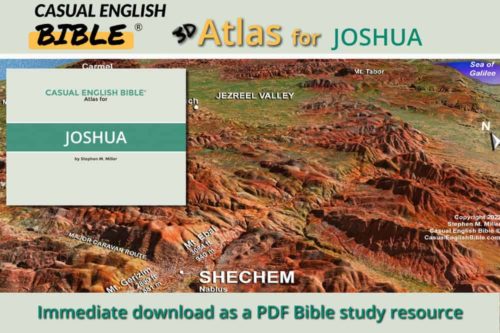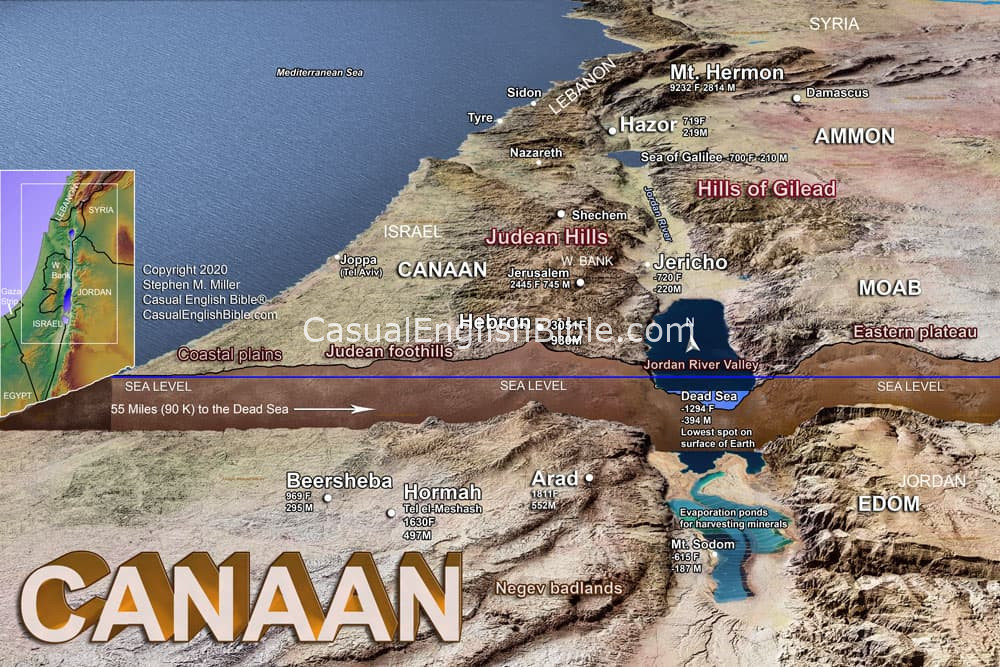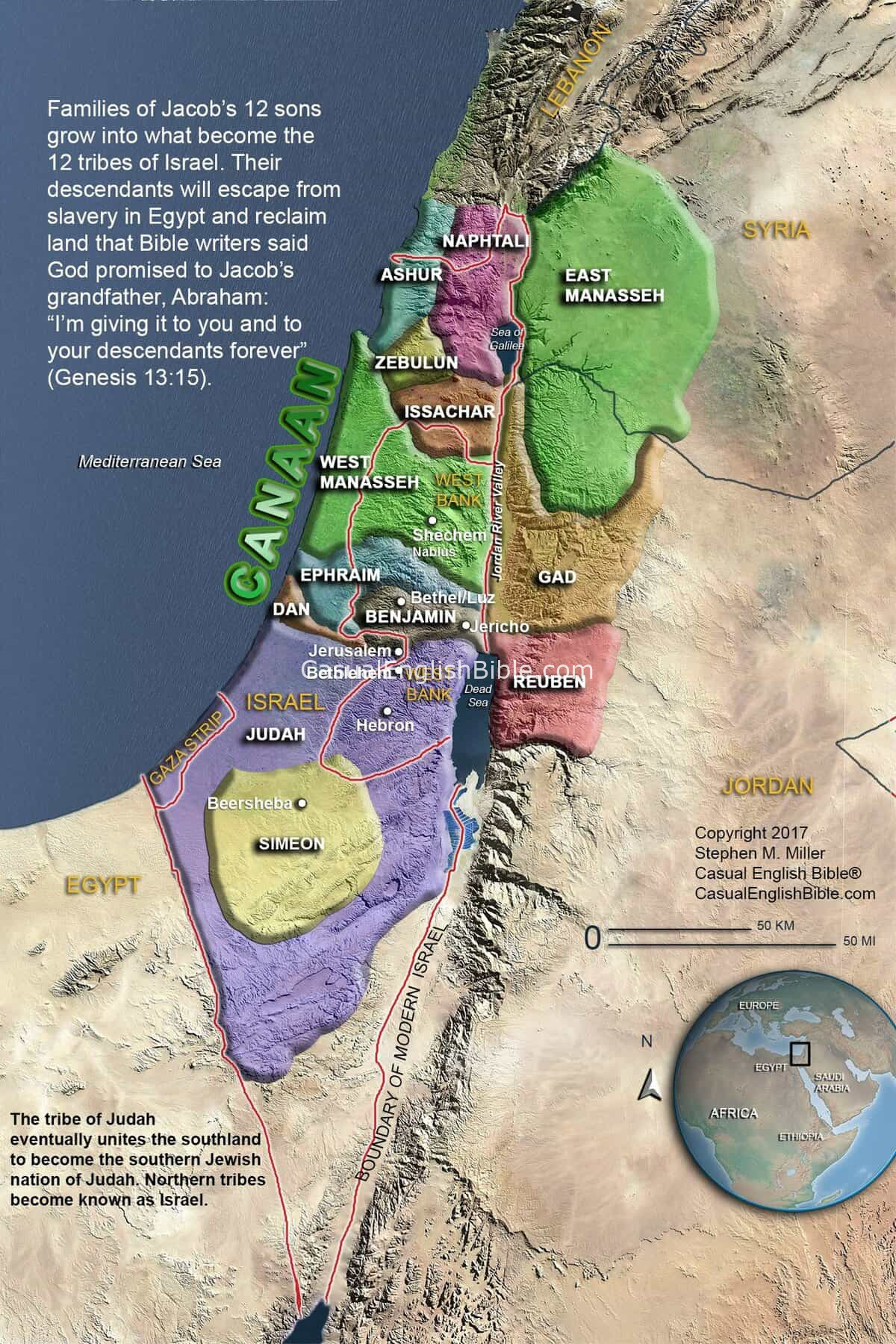Joshua 13
Looking back at land Moses assigned
Looking back at land Moses assigned
1Joshua grew old, and the LORD told him so: “You’ve gotten old. But there’s still a lot of land that the people of Israel haven’t captured. 2I have a list. This is the Canaanite land and kingdoms Israel still needs to take, starting with the land of the Philistines along with Geshur. 3Canaanites also control territory from Shihor near Egypt to Ekron in the north. Five Philistine rulers control the cities of Gaza, Ashdod, Ashkelon, Gath, and Ekron.4A group of Canaanites called Avvites also control some land 5in the south. Gebalites control some land, too. And there’s Lebanon Valley in the east, from Baal-gad at the foot of Mount Hermon to Hamath Pass. 6And there’s the hill country, from Lebanon in the north—including Sidon—to Misrephoth-maim. I’ll take care of this problem. I’ll clear all those people out of this land. 7So go ahead and divide the land among the nine tribes and the half-tribe of Manasseh." [1]
Land Moses gave the tribes
8Moses, the LORD’s devoted worker, had earlier assigned land to the tribes of Reuben, Gad, and clans that made up half the tribe of Manasseh. [2] He gave them land east of the Jordan River. 9Moses gave these tribes a territory that started in the south at the town of Aroer, near the Arnon River gorge. To the north, it included the flatland plains from Medeba to Dibon. 10It also included all the cities and outlying communities previously ruled by Amorite King Sihon of the city of Heshbon. That nation stretched north to the border of Ammon land.11Moses also assigned those tribes land in Gilead controlled by the people of Geshur and Maacah. The tribes also got all of Mount Hermon and the region of Bashan as far as Salecah. 12They got the part of Bashan previously controlled by King Og who ruled out of the cities of Ashtaroth and Edrei. He was the last of the people known as Rephaim. Moses conquered the people in all these lands and drove them away. 13The people of Geshur and Maacath were exceptions. No one ever drove them out. They still live there. 14Moses said his own tribe of Levi would get no tribal territory anywhere. Instead, he said their share of the land would come from offerings other tribes bring to the LORD, the God of Israel.
Land for Reuben’s tribe
15Moses divided Reuben’s territory among their extended family groups known as clans. 16Reuben’s tribe got the southern territory. It started at the Arnon River gorge and included the town in the middle of the valley along with the city of Aroer, nearby. Reuben’s territory extended north to the flatland plains north of Medeba. 17Reuben’s tribal land also included the King Sihon’s capital of Heshbon and all the cities and settlements in the flatland plains:Dibon, Bamoth-baal, Beth-baal-meon, 18Jahaz, Kedemoth, Mephaath, 19Kiriathaim, and Sibmah, and Zereth-shahar located on a hill above the valley, 20Beth-peor, and the hillsides Mount Pisgah, and Beth-jeshimoth. 21Reuben’s land included all the towns Amorite King Sihon had ruled from his capital in Heshbon. Moses defeated him. Moses also crushed his Midian allies who lived in Sihon’s territory: Evi, Rekem, Zur, Hur, and Reba. 22There were others the people of Israel killed. A fortuneteller, for one: Balaam, son of Beor. 23Reuben’s western border was the east bank of the Jordan River. This became Reuben’s land, with its cities and communities. Moses distributed it among Reuben’s families.
Land for Gad’s tribe
24Moses assigned the following towns and territories to clans in the tribe of Gad. 25Their territory covered half of what had been the kingdom of Ammon. This included, Jazer and the towns of Gilead. This extended as far east as the town of Aroer, which is a little west of Rabbah. 26Their territory included the city of Heshbon on Gad’s southern border. And it stretched north to include Ramath-mizpeh, Betonim, Mahanaim, and the region of Debir. [3]27Moses gave Gad all the eastern half of the Jordan River Valley, starting at the southern tip of the Sea of Galilee. It began in Beth-haram Valley in the northland, and it included Beth-nimrah, Succoth, Zaphon, and all the adjacent land once ruled by King Sihon of Heshbon. 28This became Gad’s land, with its cities and communities. Moses distributed it among Gad’s families.
Land for Manasseh’s half-tribe
29Moses also assigned land to families in the half-tribe of Manasseh. 30Moses gave them Mahanaim, a town on their southern border. To the north, they also got all the region of Bashan, which King Og once ruled. The half-tribe, led by Jair’s clan, settled into 60 towns.31The tribe also got half of Gilead. And they got King Og’s two capital cities in Bashan: Ashtaroth and Edrei. Moses assigned these lands to the people of Machir, son of Manasseh, to half the tribe.
32So, this is the land Moses assigned while Israel camped in the Plains of Moab along the east bank of the Jordan, across the river from Jericho. 33Moses gave his own tribe of Levi nothing. He said the LORD God would be enough for them.
Footnotes
113:7
“Jair, leader of the eastern half of Manasseh’s tribe, conquered the Argob territory in Bashan. He went all the way to the borders of Geshur and Maacath. Then he named all the land after himself. To this very day, the cities there are called ‘Jair Towns’ (Deuteronomy 3:14). Jair is one of the Israelite heroes often called “judges” (Judges 10:3).
213:8
The tribes of Reuben, Gad, and half the tribe of Manasseh said they liked the land east of the Jordan because it was good for grazing their livestock. So, Moses assigned it to them (Numbers 32:33).
313:26
This town is also known as Lo-debar or Lidebor. Some say this is another town. Others say they’re the same town.
Discussion Questions
- Sorry, there are currently no questions for this chapter.







